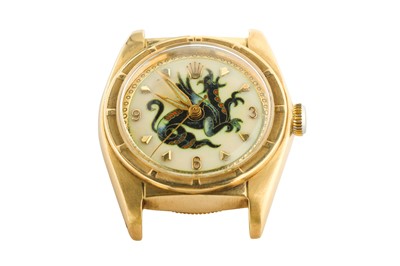13th Jun, 2019 10:00
Watches
ROLEX. EXTREMELY RARE AND FINE DRAGON CLOISONNÉ ENAMEL DIAL 14K YELLOW GOLD AUTOMATIC WRISTWATCH BAUBLE CASE Reference: 5015 Date: 1949 Movement: Signed, Perpetual Rotor, 17-Jewels, adjust to 7 position, Size -N-A, No.649XX Dial: Signed ,Stern Frère 103*507 in the back, white cloisonné enamel, rampant dragon design, applied gilt Arabic numerals quarters, arrow baton hour markers, applied gilt sword hands with luminous insert Case: Signed, 14K yellow gold brushed and polish tonneau form with reeded gold bezel bauble case, screw down back, super oyster Rolex crown, No. 653XXX Strap: Generic brown leather strap Buckle: Signed, Rolex gilt buckle Size: 32mm Weight: Approx. 44g Enamel has been used all around Europe in watchcases decoration since XVII century, having its origins in France by a goldsmith, Jean Toutin (1578-1644). Toutin developed the first enamel technique for decorating watch-cases. He originally worked in Blois, but later migrated to Paris in 1632. Different goldsmiths were using his techniques to create their masterpieces, like Pierre Huaud (1605-1680) The development of watch movements, dials and cases was improving through time, trying to achieve perfection with master watchmakers like A. L. Breguet, who achieved another big step in quality on enamelled watches during the reign of Louis XVI, when the arts and crafts flourished. All pieces were handcrafted and not created by machine. The patterns that the guillotine formed and the incisions of the Champlevé of enamel were done without the aid of mechanical gadgets or the machine. The best cloisonné dials ever produced during that period were made by the company Stern Freres (the best dial watch company in the world), who previously bought Patek Philippe in 1932 after the Depression. The brand started to design complex cloisonné enamel dials by the late 40’s for different high brands such as Pateck Philipe, Vacheron Constantin, Omega and Rolex between others. The cloisonné dials were created by the best artisans of the period, such as Charles Poluzzi, Marguerite Kock or Nelly Richard. It was usual for Rolex to go to Stern Fréres seeking assistance to create their most exceptional cloisonné dials. Enamel consists on powdered glass or ingredients of glass, to which colour in the form of powdered minerals or metallic oxides may be added while in a molten state. Then this is fused onto a “ground”, the material waiting to receive the enamel, usually metal, though sometimes porcelain or glass itself is used. When the metal was gouged out to make compartments to hold the enamel it was called champlevé. Nevertheless, one of the most difficult and beautiful processes of enameling which can be seen on the Rolex we have in the sale, was to solder gold wires onto the smooth “ground” adding multiple enamel layers to achieve the desirable colors after passing through the oven after each layer. This practice was called cloisonné. However, using this technique on the dial could increase the risk of damage the enamel during each firing of oven. A fine tone example of these pieces is found on the Rolex watch we are happy to have in the sale. The back of the dial is perfectly stamped with the Stern Fréres numbers. The first three numbers, 103, indicate Stern’s client code for Rolex, the star represents Stern Fréres and the following three numbers, 507 were the order number. Its exceptional design shows the magical combination of one of the first Rolex automatic movements with a reeded gold bezel. It was incredibly accurate, with a 14K yellow gold bubble case. The cloisonne dial depicting a legendary creature, conceived as a huge, bat-winged,-fire-breathing, scaly rampant dragon, with a black and red coiled tail, vivid red scales on the chest, spine and tail, red horn and clear blue color at the beginning of the tail, legs and wings with the gold Rolex crown situated in the middle point between the head and the wings, which are slightly touching the crown at the end of the wing, almost like an extension of itself. Gold pointed arrow hour-markers indicators and gold Arabic numbers at the 3,6 and 9 o’clock position, with a gold outer minute division. This design can be found on other cases with a bigger diameter, but for the first time we have the opportunity to see it on a bubble case of 32 mm diameter, a unusual combination since this design had to be adapted to fit the dimensions and allow the Rolex crown to overlap the dragon pattern. The beauty of the design, how the gold lines accompany the drawing on a tight twist until they became one, the vivid red and black colours melted with different tones of blue gives us a deeper appreciation of the design, almost bringing the dragon to life. This makes the dial unique. The dragon is almost floating in the middle, guarding the Rolex crown and the dagger hands coming from the middle. An incredible design, highly complex to produce by hand created by the best artisans in the world. A similar watch is illustrated and described on 100 Superlative Rolex Watches by John Goldberger (pp. 44), but slightly different dial and different case, making our watch even more exceptional nowadays. The chances of finding a watch in good working condition from that period, without replacement parts and, most importantly, with its genuine dial in very good state, are very slim. Owning one of the watches became an intriguing hunting enterprise.
Estimated at £150,000 - £300,000
Do you have an item similar to the item above? If so please click the link below to submit a free online valuation request through our website.








